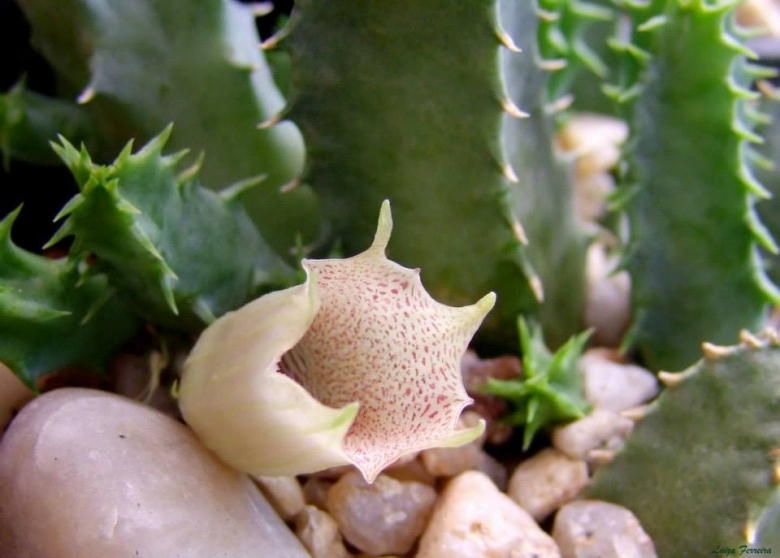




Your support is critical to our success.

Origin and Habitat: Botswana and South Aforica (Northern province, North-west Province, Free State, Nortern Cape)
Synonyms:
- Huernia longituba N.E.Br.
Description: Huernia longitubaSN|30716]]SN|30716]] is an interesting richly branched species with erect stems being four- or five-angled, with short teeth light green, sometimes tinted with purple. The flowers, which arise appear singly or in groups of 2 or 3 at the base of the stems, with a bell-shaped tube ca. 2 cm long (considerably longer than any species known), and with triangular, sharply acute corolla lobes. The interior is creamy yellow with red spots and spherical warts. The base of the tube is glabrous, smooth, and whitish, with diagonal, dark-red lines.
Stems; Erect, 2-5 cm long, 6-8 mm thick, excluding the teeth, sharply 4–5-angled, glabrous, light green, sometimes tinted with purple, scarcely glaucous. Tubercles acute.
Flowers: 1–3 together at the lower part of the young stems, facing upwards or somewhat erect, opening successively. Pedicels 12-18 mm long, 1.5 mm thick, glabrous. Bracts 5 6 mm. Sepals about 8-10 mm long, subulate from an ovate base, glabrous, lobes tubular or campanulate, 28 mm in dialter to 4 mm long, prominently 20-nerved on the glabrous smooth outside, inside (except at the base) covered with short stiff conical processes, decreasing in size towards the tips of the lobes, creamy yellow, spotted with purple, the spots becoming very crowded and darker purple at the middle part of the tube, basal part smooth and whitish, with concentric red-brown or maroon lines, the processes tipped with dark purple. Tube 18-20 mm long, 15-18 mm in diameter at the mouth, basally flat and glabrous. Corolla lobes 8-10 mm long and broad, erectly spreading in a continuous line with the tube, deltoid, very acute, erect or divaricate, rarely revolute, outside sometimes partly finely roughened the alternating teeth (papillae) at the sinuses very prominent, papillae stippled with reddish, 0.5-1.5 mm long, slender, conical, often finely mucronate. Corona 5 x 8 mm. Outer corona 5-lobed, blackish-purple or black-maroon; lobes squarish to ovate, about 1.5 mm long, dentate, crenate or emarginate obtuse at the shortly bifid apex. Inner corona-lobes 3 mm long, subterete, erect, connivent at the middle, with recurving slightly clavate obtuse tips, apparently blackish-purple or dark purple-brown. Pollinia yellow, germination mouth region brown.
Fruit: A pair of follicles. When the follicles are fully-matured they burst open to release the seeds, each of which has a tuft of hair (or coma).
Bibliography: Major references and further lectures
1) N. E. Brown. “Flora Capensis” Vol 4, 1909
2) Fl. Pl. South Africa 10: t.380 1930
3) Excelsa Taxon. Ser. 4: 60-63 1988
4) List South. African Succ. Pl. : 26 1997
5) Foden, W. & Potter, L. 2005. Huernia longituba N.E.Br. National Assessment: Red List of South African Plants version 2014.1. Accessed on 2015/03/06
6) Focke Albers, Ulrich Meve “Illustrated Handbook of Succulent Plants: Asclepiadaceae: Asclepiadaceae” Volume 4 Springer Science & Business Media, 2002
7) Werner Rauh “The Wonderful World of Succulents: Cultivation and Description of Selected Succulent Plants Other Than Cacti” Smithsonian Institution Press, 1984
Cultivation and Propagation: Not difficult to grow. Huernias require moderately watering through the growing season but enjoy plenty of water and some fertiliser in hot weather, this helps them to flower freely. Water more sparingly in winter according to temperatures. But, as with most asclepiads, it is unwise to leave them wet in cold weather.
Frost Tolerance: It is usually recommended to overwinter them in warm conditions (at 10 deg) but despite the African origin they seem to grow well and flower without the extra heat which one might have thought necessary and occasional temperature near 0 deg. are tolerated if kept dry.
Potting medium: Since roots are quite shallow, use a cactus mix or add extra perlite or pumice to regular soil potting soil. A gritty, very free-draining compost is suitable, and clay pots help the plants to dry out between watering.
Pest and diseases: Huernia species vary in their susceptibility to rotting, but are generally fairly easy to grow, especially if kept pest-free. They are very susceptible to stem and root mealy bugs, and damage from these may well initiate fungal attack. If you do have problems with a stem or with basal rotting, you can reliably isolate the healthy parts, dry them off, and re-root them in moist compost.
Propagation: Easiest with stem cuttings. Allow cuttings to dry a day before planting. Stems must be laid (Not buried) on gritty compost and will then root from the underside of the stems. It can also be increased from seeds sowing in spring in moist, sandy peat moss. Barely cover seeds. Seeds germinate quickly.
| Your Actions | |
|---|---|
| Back to Huernia index | |
| Back to Asclepiadaceae index | |
 |
Back to Succulents Encyclopedia index |
Privacy stantement - Terms and conditions - How to cite - About us - Feedback - Donate



